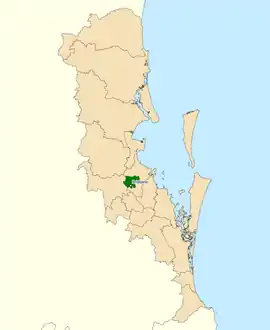Division of Brisbane
The Division of Brisbane is an Australian electoral division in the state of Queensland.
| Brisbane Australian House of Representatives Division | |
|---|---|
 Division of Brisbane in Queensland, as of the 2019 federal election. | |
| Created | 1901 |
| MP | Trevor Evans |
| Party | Liberal National |
| Namesake | Brisbane |
| Electors | 115,548 (2019) |
| Area | 57 km2 (22.0 sq mi) |
| Demographic | Inner Metropolitan |
History

The division was proclaimed in 1900, and was one of the original 65 divisions to be contested at the first federal election. It is named after the city of Brisbane.
It was in Labor hands for all but five years from 1931 to 2010, and for most of that time was a marginal Labor seat. However, a redistribution ahead of the 2010 election pushed the seat into more conservative-leaning territory east of Breakfast Creek. This helped Liberal National challenger Teresa Gambaro, previously the member for nearby Petrie from 1996 to 2007, take the seat from longtime Labor incumbent Arch Bevis, marking the first time in over a century that Labor had been in government without holding Brisbane. She was reelected in 2013 with an increased majority.
Gambaro did not re-contest the seat at the 2016 election. The contest was historic in that it was the first Australian federal election where both major party candidates in a lower house seat contest were openly gay – Trevor Evans for the Liberal Nationals and Pat O'Neill for Labor.[1] Evans retained the seat for the LNP and won re-election at 2019 election. This latter win came despite Evans being one of only three Liberal National candidates, and the only incumbent Liberal National MP, to suffer a swing against them at that election.
The seat of Brisbane has a growing Greens vote, with the party being only 2.12% short of overtaking the Labor Party on primary vote and thus likely entering the two-party preferred vote. The Greens won 2 booths at the 2019 federal election (Kelvin Grove and Spring Hill) and came second in a further 9 booths. The increase in the Greens vote in Brisbane has come largely at the expense of the Labor Party, with their vote having dropped by 22.47% from 1993, when the Greens first contested Brisbane, to 2019, where the Greens received 22.37% of the overall vote.
Boundaries
On its original boundaries, Brisbane covered all of what is now the northern part of the City of Brisbane, but successive boundary changes cut it back to the inner suburban area. However, between 1913 to 1949 the seat instead covered the inner south-west.
It now extends from the city centre into the western suburbs, and includes the Brisbane CBD, Alderley, Ashgrove, Bowen Hills, Clayfield, Enoggera, Ferny Grove, Fortitude Valley, Gaythorne, Grange, Herston, Kelvin Grove, Keperra, Milton, Mitchelton, New Farm, Newmarket, Newstead, Red Hill, Spring Hill, Upper Kedron, Wilston, Windsor, Gordon Park, Wooloowin, Lutwyche, parts of Bardon, Everton Park, Paddington and Stafford.
In the 2009 redistribution announced by the Australian Electoral Commission, the suburbs of Hendra, Ascot and Hamilton were included in the seat of Brisbane.
Members
Election results
| Party | Candidate | Votes | % | ±% | |
|---|---|---|---|---|---|
| Liberal National | Trevor Evans | 48,777 | 47.84 | −2.09 | |
| Labor | Paul Newbury | 24,970 | 24.49 | −1.42 | |
| Greens | Andrew Bartlett | 22,807 | 22.37 | +2.94 | |
| One Nation | Anne Perry | 2,537 | 2.49 | +2.49 | |
| United Australia | Aaron Whittaker | 1,420 | 1.39 | +1.39 | |
| Conservative National | Rod Jeanneret | 732 | 0.72 | +0.72 | |
| Socialist Alliance | Kamala Emanuel | 714 | 0.70 | +0.70 | |
| Total formal votes | 101,957 | 97.48 | −0.14 | ||
| Informal votes | 2,631 | 2.52 | +0.14 | ||
| Turnout | 104,588 | 90.51 | +0.67 | ||
| Two-party-preferred result | |||||
| Liberal National | Trevor Evans | 55,995 | 54.92 | −1.08 | |
| Labor | Paul Newbury | 45,962 | 45.08 | +1.08 | |
| Liberal National hold | Swing | −1.08 | |||
References
- Brisbane - 2016 election: Antony Green ABC
- Brisbane, QLD, Tally Room 2019, Australian Electoral Commission.










.jpg.webp)